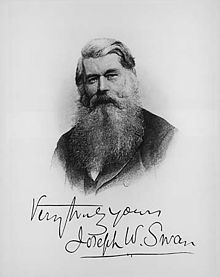Joseph Wilson Swan
Sir Joseph Wilson Swan (born October 31, 1828 in Sunderland , Durham, England, † May 27, 1914 in Warlingham, Surrey , England) was a British physicist , chemist and inventor who (mostly together with Edison , who wrote the first patents on commercially viable incandescent lamps) is considered the "inventor of the incandescent lamp" (with practical use). In 1904 Swan was knighted by King Edward VII .
Life
He first completed an apprenticeship as a pharmacist and went to Newcastle in 1846. He found a job in the chemical trade of John Mawson, whose brother-in-law he became (Mawson married his sister Elizabeth Swan (November 22, 1822 - August 2, 1905)).
As a young man, Swan saw a demonstration of Welsh William Grove's novel light bulb , but it was too expensive and didn't last long. In 1860 Swan developed his own incandescent lamp, using charred paper as a filament in an empty glass flask; It was not until 1878 that he succeeded in producing a practically usable electric incandescent lamp thanks to the revolutionary Sprengel mercury pump developed by the German Hermann Sprengel , who lived in England and which could generate a much better vacuum. In early 1879, Swan demonstrated it in Newcastle upon Tyne . He equipped his light bulbs with a special socket, the Swan socket , which, unlike the screw threads of Edison light bulbs, did not come loose when vibrated, for example in vehicles. After initial patent litigation, he was able to come to an agreement with the American Thomas Alva Edison , who shortly after him invented a similar lamp in the USA in autumn 1879 and had it patented in England in 1879 before Swan, and finally founded a jointly operated company in London in 1883 , the "Edison and Swan United Electric Light Co Ltd".
Mosley Street in Newcastle was the first electrically lit street in England, and the lamp factory required for it was in Benwell .
While looking for a better carbon thread, he found a method for manufacturing synthetic fibers, in which nitrocellulose is pressed through a spinneret and drawn into long threads. Swan also dealt with the recently discovered photography and invented a drying method using bromide paper in 1871 , which he patented in 1879. Due to its chemical nature, his bromide paper could also be used in photographic printing.
The Swan Medal is awarded in his honor . The Swan Rock , a cliff rock in the Antarctic, also bears his name.
literature
- Swan, Sir Joseph Wilson . In: Encyclopædia Britannica . 11th edition. tape 26 : Submarine Mines - Tom-Tom . London 1911, p. 179 (English, full text [ Wikisource ]).
Web links
Individual evidence
- ^ H. Vogler: Incandescent lamps and chemical fibers. On the 100th anniversary of Joseph Wilson Swan's death . In: Chem. Our time , 2014, 48, p. X
- ↑ Edison Swan Electric Co. gracesguide.co.uk; accessed on November 23, 2017.
| personal data | |
|---|---|
| SURNAME | Swan, Joseph Wilson |
| BRIEF DESCRIPTION | English physicist, chemist and inventor |
| DATE OF BIRTH | October 31, 1828 |
| PLACE OF BIRTH | Sunderland (Tyne and Wear) |
| DATE OF DEATH | May 27, 1914 |
| Place of death | Warlingham , Surrey |

